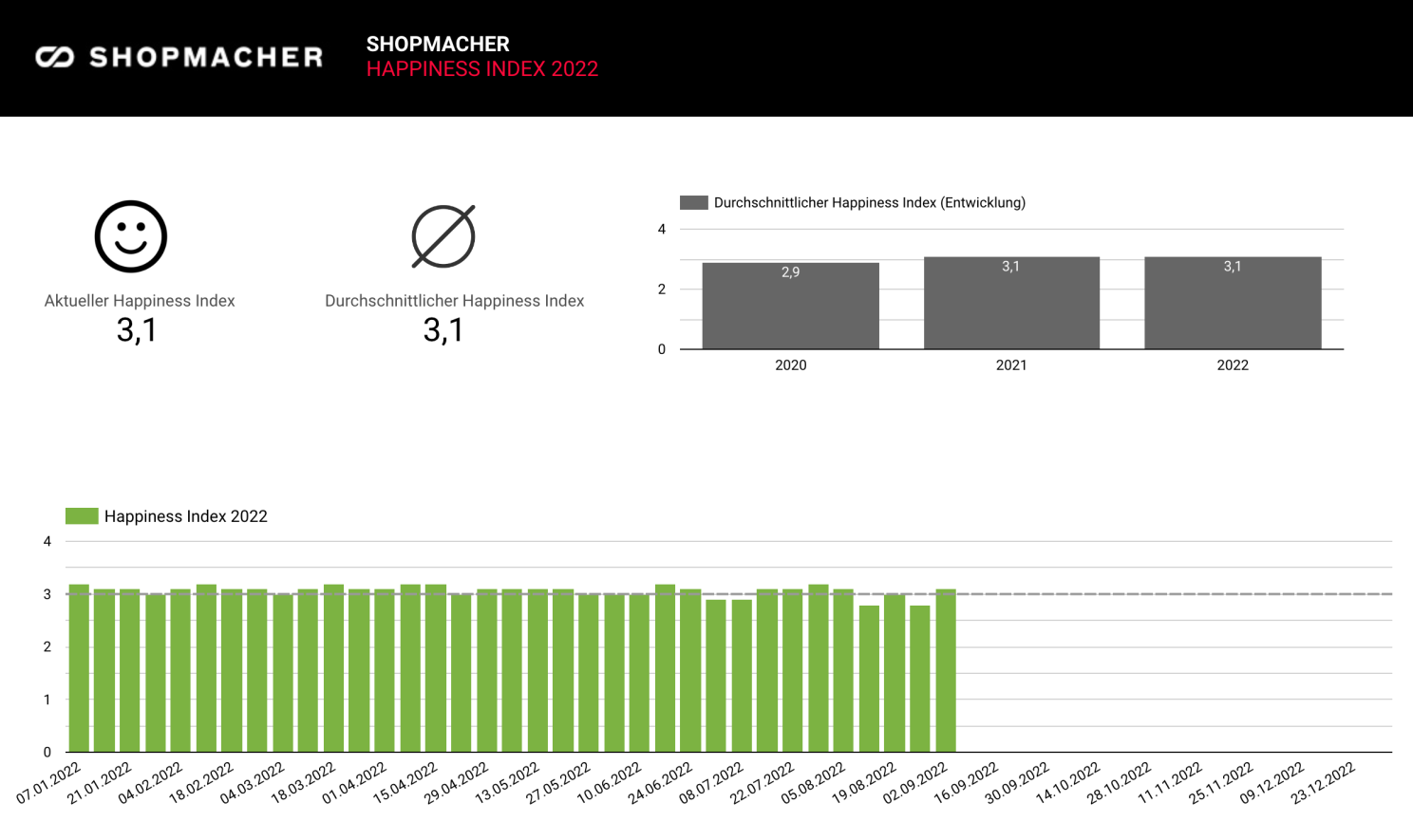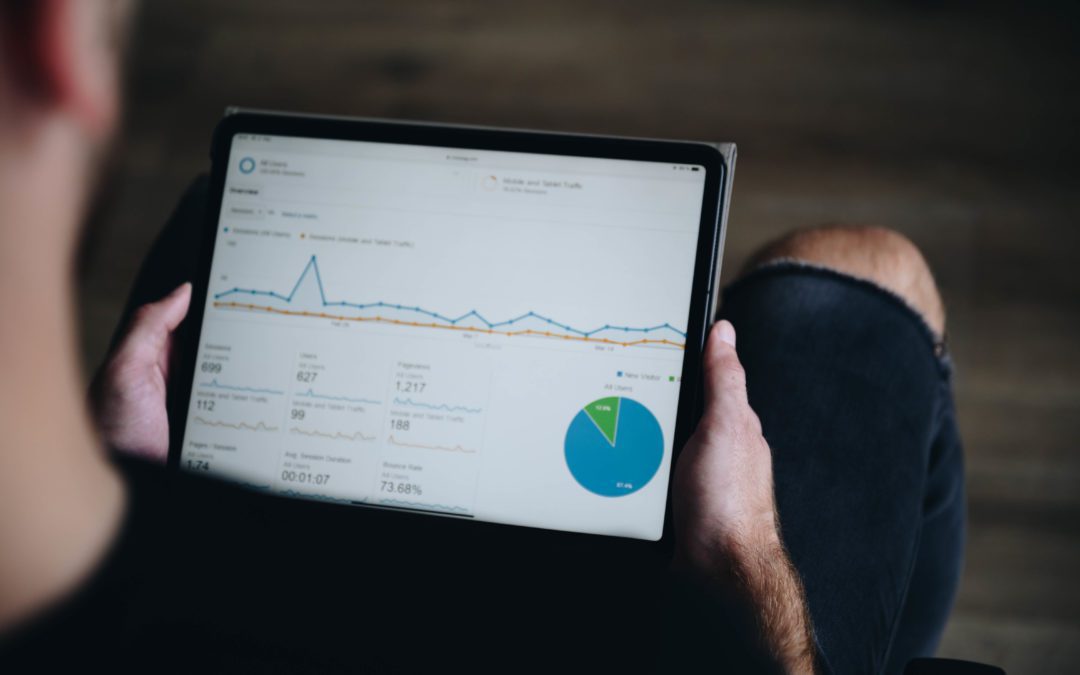The Happy Index as a parameter for strategic decisions
We measure the “Happy Index” once a week – this is about a quick answer to the simple question, “How was your week at the office?” For us, the Happy Index is an important criterion for strategic decisions. In this article André Roitzsch, CEO of Shopmacher talks André Roitzsch, CEO of Shopmacher.

We have been determining the Happy Index of our employees every week since the beginning of 2020. This is basically no big deal and goes quite quickly: Every colleague receives an automated invitation to a mini-online survey with 2 questions via our chat system on Fridays at 10am:
1st question: “How was your week?” (answer options “very good”, “good”, “bad”, “very bad)
2nd question, “What team are you on?” (answer options are just our different teams)
So we see what the mood in the individual teams is right now, otherwise the mini-survey is anonymous and also not qualitatively oriented. We do not receive any assessments of management quality, potential for improvement, etc. here. We survey this 1x a year in a more comprehensive employee survey.
With the Happy Index, we are only interested in capturing a current mood picture. That’s what we have every week for each team and the whole squad. Our Vietnamese colleagues are also there, of course.
By the way, the maximum value for our Happy Index would be 4.0 for the four answer options if all colleagues had a very good week. I have as a personal goal in mind that he should reach 3.0 if possible. When we started it was 2.8, this year we are averaging 3.1.

The development of the “Happy Index
Why are we doing this and what do we hope to achieve?
As a rule, a single Happy Index is hardly meaningful for anything, because the qualitative component is missing. What is exciting are trends, correlations with certain events – and conclusions that can be drawn from them at the macro level.
Examples:
- Is the mood better or worse at certain times of the year? >> We were not able to determine this.
- Is a very high utilization rate bad for the mood? >> No, quite the opposite. If anything, we have found that the index goes down when there is less to do.
- What happens to the Happy Index when the entire workforce moves to the home office in April 2020? >> It is falling – and significantly so.
- What happens to the Happy Index when, after 2 years of remote work, we gently pressure colleagues to spend more time in the office again and offer incentives to revive team spirit? >> It drops slightly at first (it was so cozy at the PC at home?), but then rises again more strongly (perhaps because team spirit that can be experienced physically is a great thing after all?).
As can be seen from the examples, much remains vague, of course. We interpret the changes without conclusive certainty about causalities. But over time, our interpretations get better and better simply because we gain more and more data and certain correlations accumulate. We primarily observe trends and correlations with specific events. We then draw conclusions from this.
Nevertheless, some of my colleagues have asked me what the point of this is – even to the point of saying, “I hardly ever take part in this anymore, nothing changes anyway. (By the way, participation is around 60-70% of the workforce).
From this I then learn again that I should explain the meaning and purpose of the whole matter even better.
First of all: Of course we don’t order a clown if several people had a bad week at once. And we can’t then spontaneously adjust salaries or simply terminate a particular project without regard to ongoing contracts. Our Happy Index is geared to the long term.
But I do think it’s remarkable that an employer would say, “It’s important to me that you’re happy, so I really do ask you every week how you’re doing.” And then I sit there once a month with my colleagues from HR and Agile Coaching about the results, we ponder what this or that trend can be due to and how we can positively influence it. This is employee-centeredness in action: We want people to feel really good about what they do here. And with the Happy Index we learn and err ahead.

André Roitzsch, CEO of Shopmacher
OUR HAPPY INDEX IS DESIGNED FOR THE LONG TERM
We turned down a commercially really attractive project with thanks because we were worried that “the Happy Index would blow up in our faces if we actually did this project” (original quote from a colleague).
To be fair, I have to say that it wasn’t just the concern about the Happy Index that was the deciding factor, but a number of parameters didn’t fit and we’re busy right now overall (like many good digital agencies) – but it wasn’t that we couldn’t have provided the capacity for the planned project period either. We simply didn’t want to, because we thought it wouldn’t do us or our colleagues any good under the given conditions on the customer side.
And so the small, simple and perhaps sometimes underestimated Happy Index has become a parameter for corporate strategy decisions among shopmakers. Who would have thought that?
ALSO INTERESTING

Measuring success: 10 important KPIs for the online shop
The right Key Performance Indicators (KPI) help to optimize online shops. Which key figures retailers should keep an eye on: Many retailers measure the success of their web presence by sales.

Ecommerce white paper
Have you launched a new e-commerce instance? Congratulations! Now it really starts – how do we tell you in the whitepaper!

Level upgrade: gamescom now trusts SHOPMACHER again
After two years in which gamescom was held exclusively online, the world’s largest games event will become a hybrid event this year. Shopmacher is responsible for the further development of the digital customer experience on the “gamescom now” content hub.